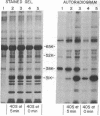Abstract
A previous study demonstrated that the translational inhibitor from lysates of heme-deficient rabbit reticulocytes is associated with a protein kinase activity. Chromatography of this inhibitor preparation on phosphocellulose yields two distinct protein kinase activities, PC1 and PC2. PC1, which consitutes about 90% of the activity in the unresolved preparation, does not inhibit protein synthesis in lysates, but actively phosporylates calf thymus histone II in a 3':5'-cyclic AMP-denpendent reaction. PC2 contains the translational inhibitor, phosphorylates histone poorly, and is not cyclic AMP-dependent. While [gamma-32P]ATP as the phosphate donor, the two kinase fractions were analyzed with the putative substrates, salt-washed 40S ribosomal subunits, and the initiation factor that mediates the binding of Met-tRNAf to the 40S subunit. PC1 is inactive with the initiation factor, but phosphorylates 40S subunits at a single major site that migrates as a 31,000-dalton band in sodium dodecyl sulfate-acrylamide gels; phosphorylation requires cyclic AMP. Similar phosphorylation of the reticulocyte 40S site (31,000 daltons) can be demonstrated with other cyclic AMP-dependent kinases from reticulocytes, rat liver, and bovine heart muscle. PC2 phosphorylates the small subunit (38,000 daltons) but not the large subunit(s) of the initiation factor; the reaction does not require cyclic AMP. PC2 does not phosphorylate 40S subunits. In the presence of 40S subunits, the initiation factor appears to be rapidly bound in a manner that effectively blocks phosphorylation of the initiation factor by PC2; under the same conditions phosphorylation of the 40S subunit by PC1 is not affected. The initiation factor has been shown to reverse the inhibitions of protein chain initiation induced in lysates by heme deficiency, double-stranded RNA, oxidized glutathione, or the purified translational inhibitor. The observation that the Met-tRNAf binding factor is phosphorylated by PC2 supports the hypothesis that this initiation factor is a target for the action of the translational inhibitor activated in heme deficiency.
Full text
PDF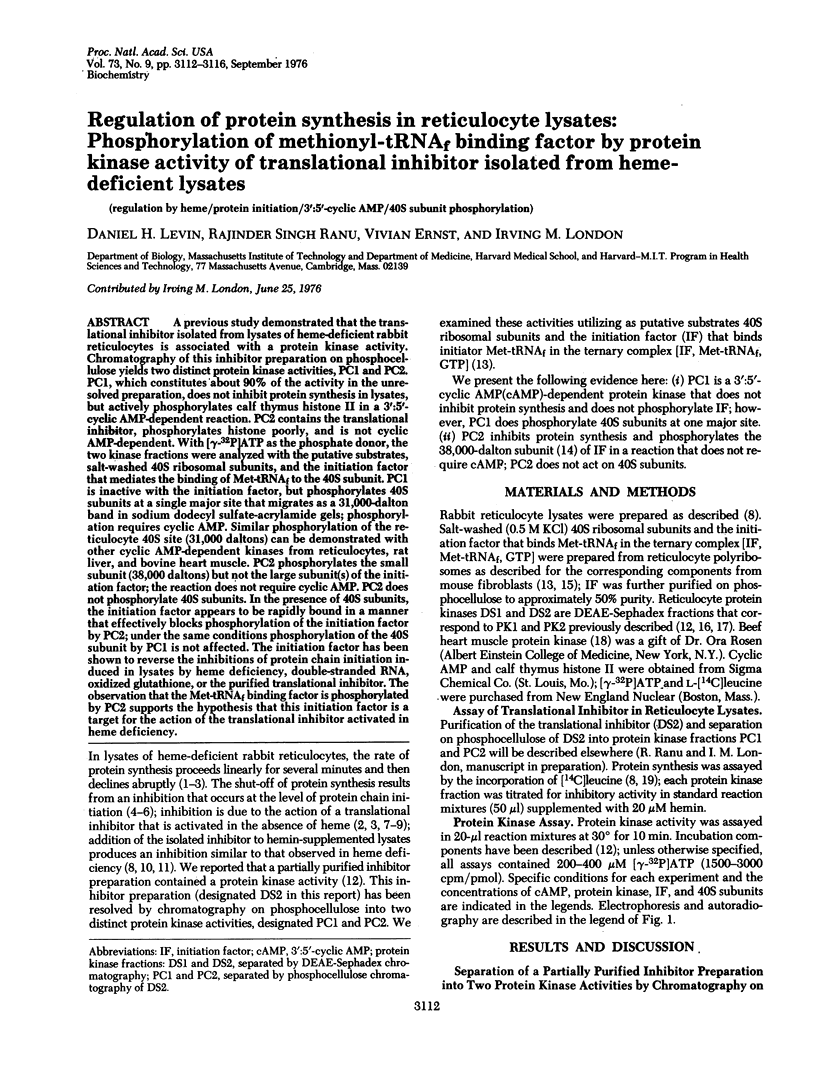
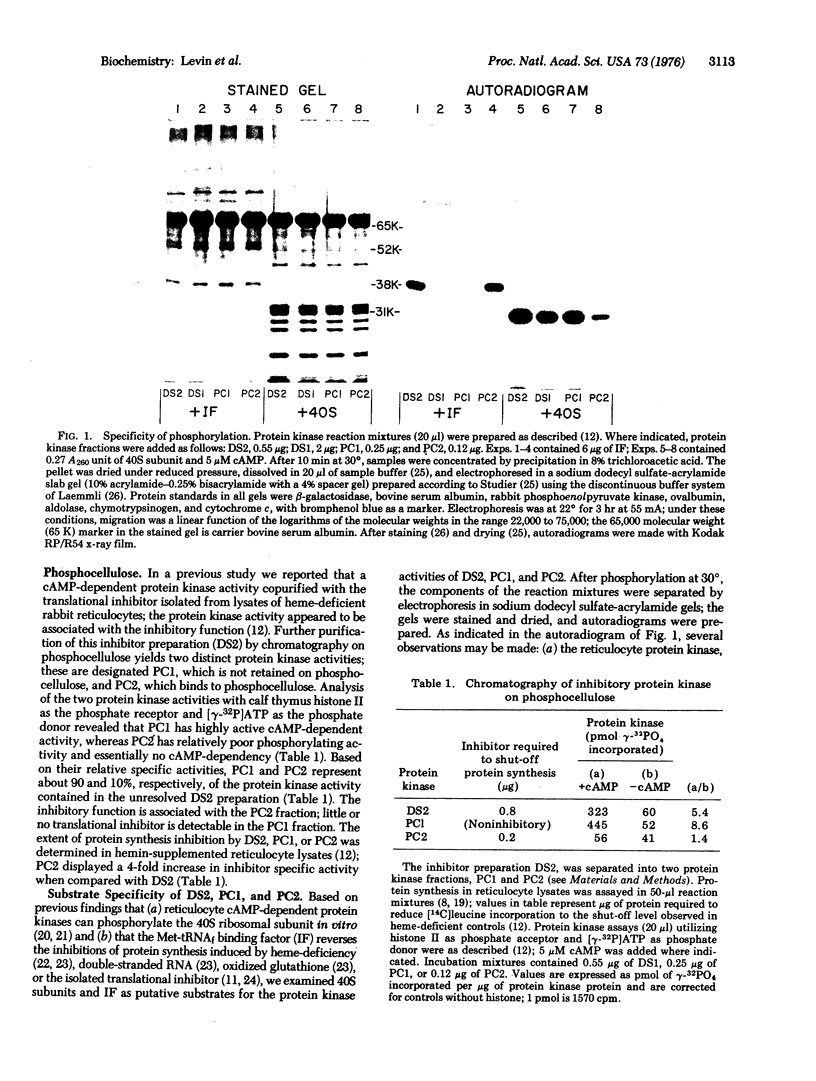
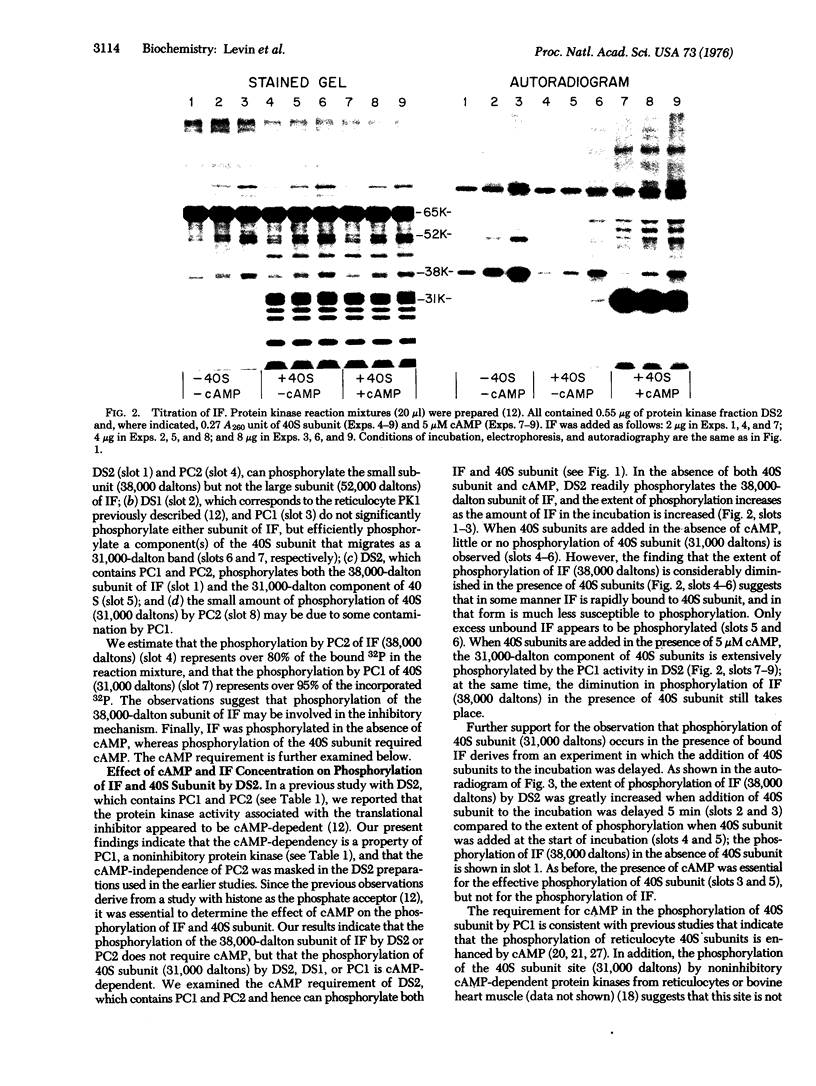
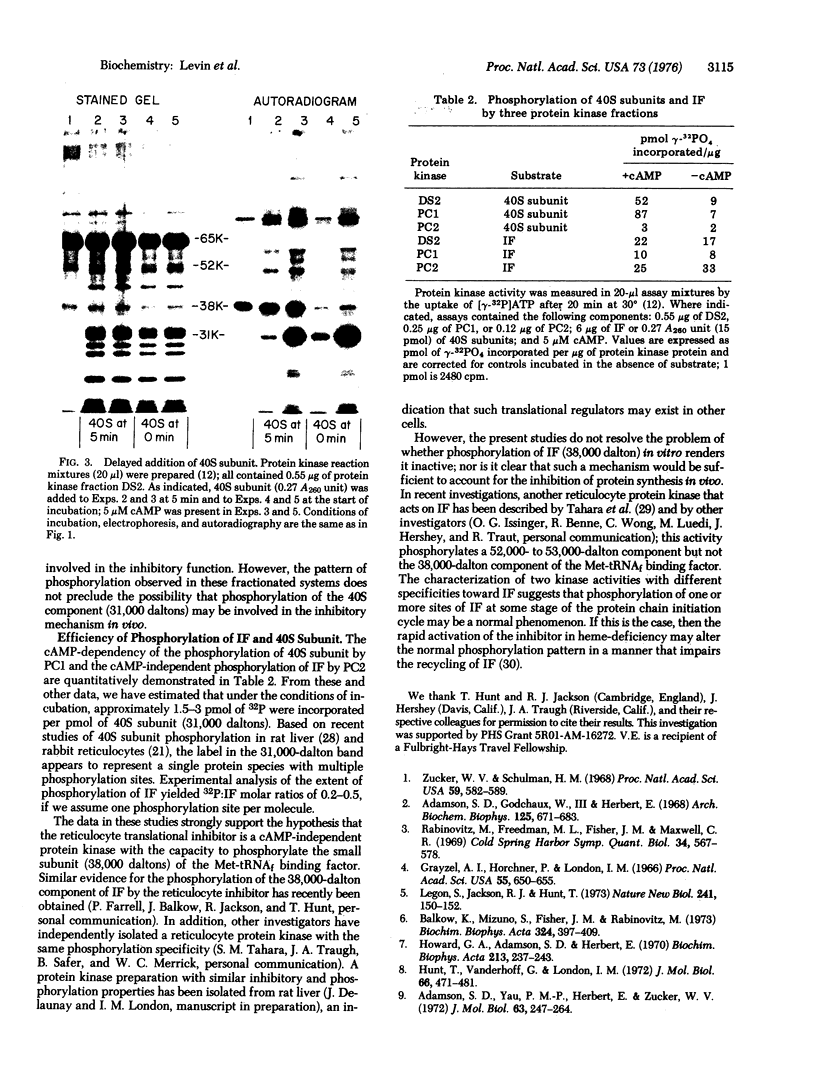
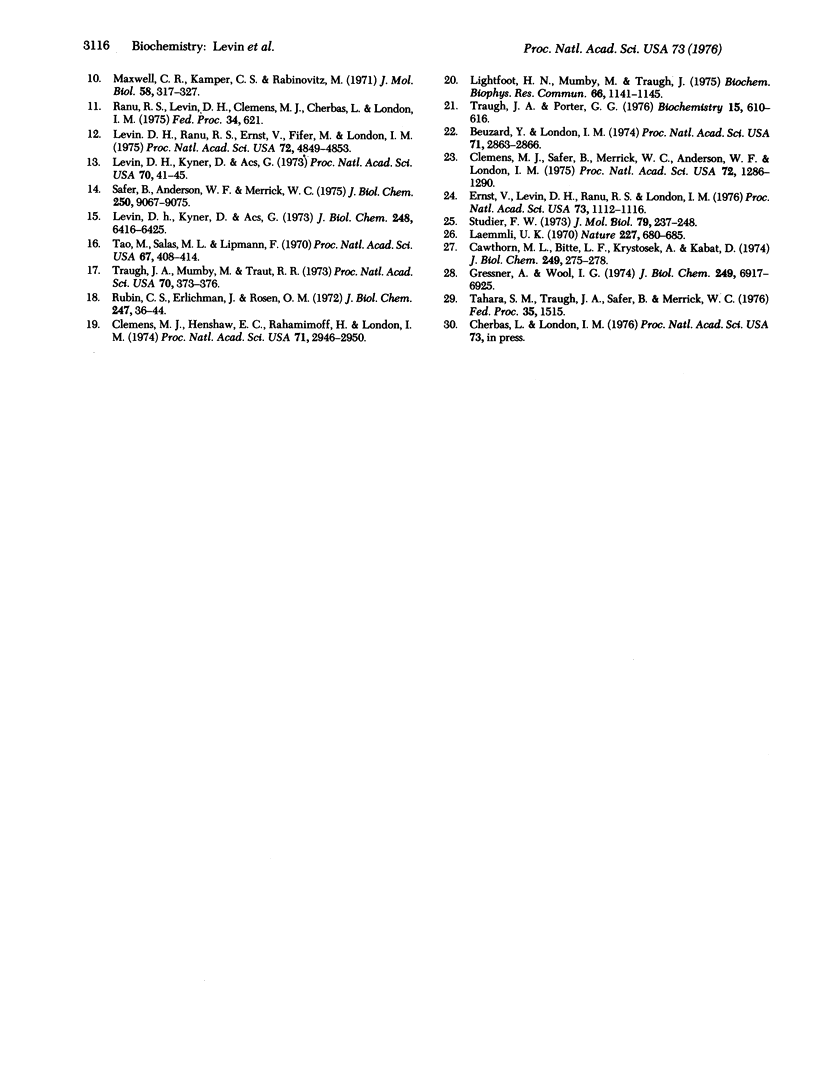
Images in this article
Selected References
These references are in PubMed. This may not be the complete list of references from this article.
- Adamson S. D., Herbert E., Godchaux W. Factors affecting the rate of protein synthesis in lysate systems from reticulocytes. Arch Biochem Biophys. 1968 May;125(2):671–683. doi: 10.1016/0003-9861(68)90625-5. [DOI] [PubMed] [Google Scholar]
- Adamson S. D., Yau P. M., Herbert E., Zucker W. V. Involvement of hemin, a stimulatory fraction from ribosomes and a protein synthesis inhibitor in the regulation of hemoglobin synthesis. J Mol Biol. 1972 Jan 28;63(2):247–264. doi: 10.1016/0022-2836(72)90373-7. [DOI] [PubMed] [Google Scholar]
- Balkow K., Mizuno S., Fisher J. M., Rabinovitz M. Hemin control of globin synthesis: effect of a translational repressor on Met-tRNAf binding to the small ribosomal subunit and its relation to the activity and alailability of an initiation factor. Biochim Biophys Acta. 1973 Oct 26;324(3):397–409. doi: 10.1016/0005-2787(73)90284-0. [DOI] [PubMed] [Google Scholar]
- Beuzard Y., London I. M. The effects of hemin and double-stranded RNA on alpha and beta globin synthesis in reticulocyte and Krebs II ascites cell-free systems and the relationship of these effects to an initiation factor preparation. Proc Natl Acad Sci U S A. 1974 Jul;71(7):2863–2866. doi: 10.1073/pnas.71.7.2863. [DOI] [PMC free article] [PubMed] [Google Scholar]
- Cawthon M. L., Bitte L. F., Krystosek A., Kabat D. Effect of cyclic adenosine 3':5'-monophosphate on ribosomal protein phosphorylation in reticulocytes. J Biol Chem. 1974 Jan 10;249(1):275–278. [PubMed] [Google Scholar]
- Clemens M. J., Henshaw E. C., Rahamimoff H., London I. M. Met-tRNAfMet binding to 40S ribosomal subunits: a site for the regulation of initiation of protein synthesis by hemin. Proc Natl Acad Sci U S A. 1974 Aug;71(8):2946–2950. doi: 10.1073/pnas.71.8.2946. [DOI] [PMC free article] [PubMed] [Google Scholar]
- Clemens M. J., Safer B., Merrick W. C., Anderson W. F., London I. M. Inhibition of protein synthesis in rabbit reticulocyte lysates by double-stranded RNA and oxidized glutathione: indirect mode of action on polypeptide chain initiation. Proc Natl Acad Sci U S A. 1975 Apr;72(4):1286–1290. doi: 10.1073/pnas.72.4.1286. [DOI] [PMC free article] [PubMed] [Google Scholar]
- Ernst V., Levin D. H., Ranu R. S., London I. M. Control of protein synthesis in reticulocyte lysates: effects of 3':5'-cyclic AMP, ATP, and GTP on inhibitions induced by hemedeficiency, double-stranded RNA, and a reticulocyte translationa inhibitor. Proc Natl Acad Sci U S A. 1976 Apr;73(4):1112–1116. doi: 10.1073/pnas.73.4.1112. [DOI] [PMC free article] [PubMed] [Google Scholar]
- Grayzel A. I., Hörchner P., London I. M. The stimulation of globin synthesis by heme. Proc Natl Acad Sci U S A. 1966 Mar;55(3):650–655. doi: 10.1073/pnas.55.3.650. [DOI] [PMC free article] [PubMed] [Google Scholar]
- Gressner A. M., Wool I. G. The phosphorylation of liver ribosomal proteins in vivo. Evidence that only a single small subunit protein (S6) is phosphorylated. J Biol Chem. 1974 Nov 10;249(21):6917–6925. [PubMed] [Google Scholar]
- Howard G. A., Adamson S. D., Herbert E. Studies on cessation of protein synthesis in a reticulocyte lysate cell-free system. Biochim Biophys Acta. 1970 Jul 16;213(1):237–240. doi: 10.1016/0005-2787(70)90028-6. [DOI] [PubMed] [Google Scholar]
- Hunt T., Vanderhoff G., London I. M. Control of globin synthesis: the role of heme. J Mol Biol. 1972 May 28;66(3):471–481. doi: 10.1016/0022-2836(72)90427-5. [DOI] [PubMed] [Google Scholar]
- Laemmli U. K. Cleavage of structural proteins during the assembly of the head of bacteriophage T4. Nature. 1970 Aug 15;227(5259):680–685. doi: 10.1038/227680a0. [DOI] [PubMed] [Google Scholar]
- Legon S., Jackson R. J., Hunt T. Control of protein synthesis in reticulocyte lysates by haemin. Nat New Biol. 1973 Jan 31;241(109):150–152. doi: 10.1038/newbio241150a0. [DOI] [PubMed] [Google Scholar]
- Levin D. H., Kyner D., Acs G. Protein initiation in eukaryotes: formation and function of a ternary complex composed of a partially purified ribosomal factor, methionyl transfer RNA, and guanosine triphosphate. Proc Natl Acad Sci U S A. 1973 Jan;70(1):41–45. doi: 10.1073/pnas.70.1.41. [DOI] [PMC free article] [PubMed] [Google Scholar]
- Levin D. H., Kyner D., Acs G. Protein synthesis initiation in eukaryotes. Characterization of ribosomal factors from mouse fibroblasts. J Biol Chem. 1973 Sep 25;248(18):6416–6425. [PubMed] [Google Scholar]
- Levin D. H., Ranu R. S., Ernst V., Fifer M. A., London L. M. Association of a cyclic AMP-dependent protein kinase with a purified translational inhibitor isolated from hemin-deficient rabbit reticulocyte lysates. Proc Natl Acad Sci U S A. 1975 Dec;72(12):4849–4853. doi: 10.1073/pnas.72.12.4849. [DOI] [PMC free article] [PubMed] [Google Scholar]
- Lightfoot H. N., Mumby M., Traugh J. A. Dephosphorylation of 40S ribosomal subunits by phosphoprotein phosphatase activity from rabbit reticulocytes. Biochem Biophys Res Commun. 1975 Oct 27;66(4):1141–1146. doi: 10.1016/0006-291x(75)90477-5. [DOI] [PubMed] [Google Scholar]
- Maxwell C. R., Kamper C. S., Rabinovitz M. Hemin control of globin synthesis: an assay for the inhibitor formed in the absence of hemin and some characteristics of its formation. J Mol Biol. 1971 May 28;58(1):317–327. doi: 10.1016/0022-2836(71)90249-x. [DOI] [PubMed] [Google Scholar]
- Rabinovitz M., Freedman M. L., Fisher J. M., Maxwell C. R. Translational control in hemoglobin syntheskis. Cold Spring Harb Symp Quant Biol. 1969;34:567–578. doi: 10.1101/sqb.1969.034.01.064. [DOI] [PubMed] [Google Scholar]
- Rubin C. S., Erlichman J., Rosen O. M. Molecular forms and subunit composition of a cyclic adenosine 3',5'-monophosphate-dependent protein kinase purified from bovine heart muscle. J Biol Chem. 1972 Jan 10;247(1):36–44. [PubMed] [Google Scholar]
- Safer B., Anderson W. F., Merrick W. C. Purification and physical properties of homogeneous initiation factor MP from rabbit reticulocytes. J Biol Chem. 1975 Dec 10;250(23):9067–9075. [PubMed] [Google Scholar]
- Studier F. W. Analysis of bacteriophage T7 early RNAs and proteins on slab gels. J Mol Biol. 1973 Sep 15;79(2):237–248. doi: 10.1016/0022-2836(73)90003-x. [DOI] [PubMed] [Google Scholar]
- Tao M., Salas M. L., Lipmann F. Mechanism of activation by adenosine 3':5'-cyclic monophosphate of a protein phosphokinase from rabbit reticulocytes. Proc Natl Acad Sci U S A. 1970 Sep;67(1):408–414. doi: 10.1073/pnas.67.1.408. [DOI] [PMC free article] [PubMed] [Google Scholar]
- Trauch J. A., Mumby M., Traut R. R. Phosphorylation of ribosomal proteins by substrate-specific protein kinases from rabbit reticulocytes. Proc Natl Acad Sci U S A. 1973 Feb;70(2):373–376. doi: 10.1073/pnas.70.2.373. [DOI] [PMC free article] [PubMed] [Google Scholar]
- Traugh J. A., Porter G. G. A comparison of ribosomal proteins from rabbit reticulocytes phosphorylated in situ and in vitro. Biochemistry. 1976 Feb 10;15(3):610–616. doi: 10.1021/bi00648a025. [DOI] [PubMed] [Google Scholar]
- Zucker W. V., Schulman H. M. Stimulation of globin-chain initiation by hemin in the reticulocyte cell-free system. Proc Natl Acad Sci U S A. 1968 Feb;59(2):582–589. doi: 10.1073/pnas.59.2.582. [DOI] [PMC free article] [PubMed] [Google Scholar]





